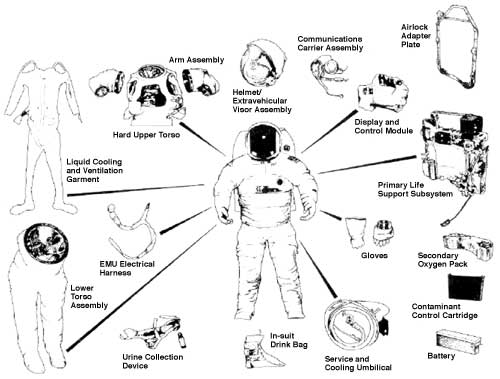
Chapter Links
Home
Members
Events
Projects
Gallery
Educational Outreach
Donations and Sponsors
Current Weather Reports
So you want to be an Astronaut
Mars Links
Mars Society Links
Mars Society
Founding Declaration
Mars Desert Research Station
Flashline Mars Arctic Research Station
Sign the Mars Petition
Requests concerning this Web site should be directed to the Webmaster.
General queries should be directed to MarsSocInfo@aol.com
Copyright © 2001 The Mars Society. All rights reserved.
|
NASA Information Summaries PMS-033 (JSC) Wardrobe for Space Part Two: Wardrobe for the space shuttle era (cont.)
Suiting up • A urine-collection device that receives and stores urine for transfer later to the orbiter waste management system. • A liquid cooling and ventilation garment, a one-piece mesh suit made of spandex, zippered for front entry, and weighing 6.5 pounds dry. The garment has water-cooling tubes running through it to keep the wearer comfortable during active work periods. • An in-suit drink bag containing 21 ounces of potable water, the "Snoopy Cap," or communications carrier assembly, with headphones and microphones for two-way communications and caution-and-warning tones, and a biomedical instrumentation subsystem. To put on the spacesuit, the astronaut first dons the lower torso assembly and then rises into the top section of the two-piece EMU spacesuit hanging on the wall of the airlock. The upper torso of the spacesuit is a hard-shell fiberglass structure that contains the primary life support system and the display control module. Connections between the two parts must be aligned to enable circulation of water and gas into the liquid cooling ventilation garment and return. Then, the gloves are added and last to be donned is the extravehicular visor and helmet assembly, which provides protection from micrometeoroids and from solar ultraviolet and infrared radiation. Bearings in the shoulder, arm, wrist, and waist joints allow the crewmember freedom of movement. Bending, leaning, and twisting motions of the torso can all be done with relative ease. |
|
|
Continue Part Two: Wardrobe for the space shuttle era |
|
